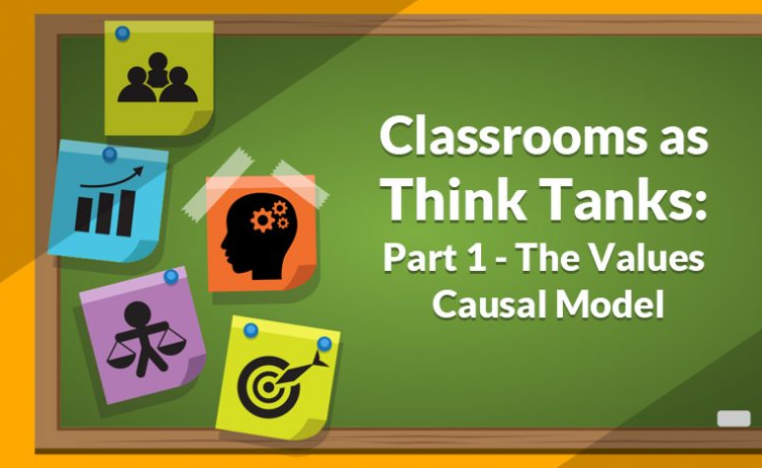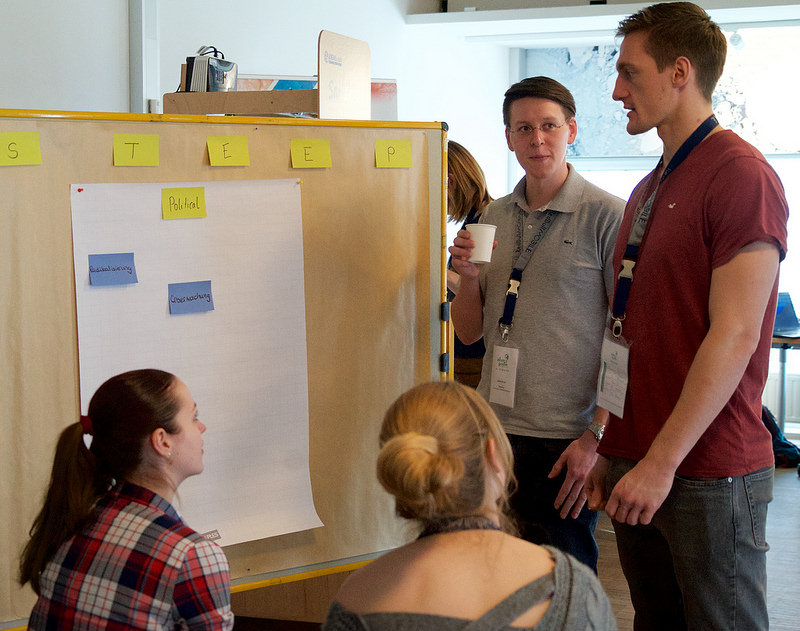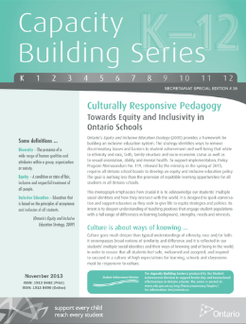|
In the last post, you read how developing and enacting our personal resources to creating community and belonging is critical for student learning and can be done at each level of service--classroom, school, and district.
Engaging student voice, cycling through inquiry, driving conversations with data, and building coherence between these levels will ensure that we are helping to improve learning for all. |
Ask yourself what it is about particular districts where coherence is evident and working. I think you'll find that their professional learning model(s) seek to help educators uncover student needs and engage in inquiry that not only helps them to learn how to best meet those needs but also invites students to co-construct conditions that will improve their chances for success.
|
Based on the pathways provided in Figure 1, if you know that your team's collaborative dynamics are well-structured and working, I would encourage you and your team to move forward with a sample inquiry and model for professional learning that leverages Student Voice (see link, right).
On the other hand, if you know that it is better for you and your team to take more time to culture collaborative norms, I would encourage you to complete the posted activity in its entirety (below; "Starting with a Values-Causal Model"). |
|
Author of "Classrooms as Think Tanks: Part 1 - The Values Causal Model," Jennifer Warren (2018) explains that getting to innovative thinking requires that we generate ideas collectively. And it is through this type of thinking that we are better able to solve problems--all of it made possible by being comfortable "[wading] into complexity with confidence." This means that we need to make community-building central to what we do alongside students.
|
I have taken inspiration from the model and have created an exercise (see below) that could help you and your team(s) determine what they value most about one another, and further to this, what they value most about teaching and learning. You see, developing a set of shared beliefs is a powerful motivation for teams to collaborate and learn deeply.
And with similarities set aside, the real value in this model is its ability to highlight different perspectives. Without these perspectives, it’s impossible to generate better ideas...the kinds of ideas that can lead to efficient and effective, innovative problem solving.
-Grab a piece of paper, leaving the middle open.
-Thinking deeply about it, write out as many items as you can around the middle, open space you’ve left--that is, your responses to the prompt, "What makes you, you?"
-Take a ‘step’ away from your scribbles…(stay away a bit longer)...now come back to the page. Do you have any additions/revisions you want to make?
-Might you be able to make links with some of the items you’ve listed? Take some time to do this.
-Now come back to the middle, open space. This is you. The middle open, space is a confluence of all of the items you’ve written, along with their connections. Let’s call these items values.
-In that middle space, take some time to fill it with a theme or themes...that is, a representation of you. It can be a word, several words, a picture (or pictures)...the idea is not to over-qualify “you” with a lot of details. Allow the brevity of the small collection of themes to take over.
|
Part 3
-Reach out to your partner(s). -Share the representation of “you.” As you listen, do exactly that...give your partner time to fully express their thinking. -Following their explanation, take a moment to ask clarifying questions (if needs be). -Switch roles, following the same steps. This protocol, although simple, can help us to listen interpretively as opposed to responsively. The goal is for each of you (and collectively) to stay in a reflective space. |
Now take a moment to consider the following:
Personal:
-Do I “see” my partner(s) differently? How so?
-Do I “see” myself differently? How so?
-What am I feeling from having done this activity?
As Pairs/Whole-Group:
-Having asked your partner, what are they feeling?
-Do you know yourself/partner better than before? Why?
-If you can say that you feel like you belong (relative to the perspectives of your partner), what shared belief(s)/value(s) are bringing you together?
|
Learning Activity #2-Reflecting Through Culturally-Responsive Pedagogy
Either on your own or with your partner(s), go back to the earlier parts of the activity. Apply the following lens(es)/dimensions to qualify some of the items/aspects of your sketch, accordingly. I recommend that you "stay the course" with this final reflection: insights as to how you (and your team) will focus direction for collaborative work will start to emerge. As they do, and without getting drawn away from the activity, take brief moments to document these somewhere, and come back to them later on. Note: To clarify the meaning of the lenses, a description has been provided for each one (Culturally-Responsive Pedagogy, 2015). |
Institutional
- Reflecting “...values developed and reflected in school board policies and practices…”
- Reflecting [your] educator’s mindset “...and the practices [you] engage in, in order to support the development of all students…”
- Reflecting “...knowing [your] learners well and considering [your] classroom practices which lead to a culturally-responsive classroom."
By integrating these lenses into our thinking...into the way we engage in our professional practice, we come to a deepened sense of understanding of how "culture goes much deeper than typical understandings of ethnicity, race and/or faith.
It encompasses broad notions of similarity and difference and it is reflected in our students’ multiple social identities and their ways of knowing and of being in the world.
In order to ensure that all students feel safe, welcomed and accepted, and inspired to succeed in a culture of high expectations for learning, schools and classrooms must be responsive to culture" (Culturally-Responsive Pedagogy, 2013).
Now that you've completed this learning activity, work your way back to the flowchart (above) and/or consider what follows.
In order to gain diverse perspectives on creating conditions for transforming student learning, I administered two, on-line surveys to educators. The first, survey prompt was as follows: "What would you consider a pillar for transforming student learning?" Several days later, I followed up with a second prompt--the wording slightly adjusted for greater precision ("What would you consider a pedagogical pillar for transforming student learning?")
Both surveys remain active and are included below for you. As the surveys collect no information but your perspectives, I would like to encourage you (and your teams) to share your beliefs/values from Learning Activity #1, #2 or both.
Once complete, you can also view the results through the links provided below each of the surveys.
Given this sample of responses, discuss with your partner(s) some of these pillars/values to creating culturally-responsive spaces for student learning.
-Would you add any of these to your, personal sketch?
-Is the collective graphic missing any pillars you would deem important?
-How would you rank these in terms of importance to you? How would they rank in importance to your students?
In closing, I would like to thank you for working through the learning activities and sharing your insights. I can't help but to think of the deep class and school conversations that can be inspired when we take collective action to improving student learning.
As this blog is a means for readers to network and gradually change the context for how you/your class/school/district operates, we all benefit by drawing nearer to the perspectives shared here and shared beyond with our professional learning networks.
I am more than happy to collaborate with you and feature our learning, here, in this blog and across Flipping the Focus' social media platforms (Facebook and Instagram at
FlippingtheFocus and Twitter @flip4change), as well as those of your own.
Contact Flipping the Focus to see how we can work together towards achieving your/your organization's goals.
Chris Stewart, OCT
Educational Consultant, Flipping the Focus, (c) 2018
Culturally-Responsive Pedagogy
- Ontario Ministry of Education, Literacy & Numeracy Secretariat. (2013). Culturally-Responsive Pedagogy (35th ed., Capacity Building Series, pp.1-8). Retrieved from http://www.edu.gov.on.ca/eng/literacynumeracy/inspire/research/cbs_responsivepedagogy.pdf
Leadership/School Improvement
- Breakspear, S. (2015). Overview of Learning Sprints [Video blog post]. Retrieved from https://vimeo.com/282261789
Pedagogical Practice
- Warren, J. (2018, August 13). Classrooms as Think Tanks: Setting the Conditions for a Thinking Classroom Part 1: The Values Causal Model. Retrieved from https://thelearningexchange.ca/classrooms-as-think-tanks-setting-the-conditions-for-a-thinking-classroom-part-1-the-values-causal-model/
School & System - Learning & Change
- Dawes, P. (2018, April 2). Moving from Professional Development to Professional Learning [Web log post]. Retrieved from https://www.edushift.ca/articles/moving-from-professional-development-to-professional-learning
Further Reading (suggested)
Collaborative Professionalism
- Hargreaves, A., & O'Connor, M. T. (2018). Collaborative professionalism: When teaching together means learning for all. Thousand Oaks, CA: Corwin, a SAGE Company.
- Hargreaves, A & O’Connor, M.T. (2018). Seminar Series 274: Leading Collaborative Professionalism, Centre for Strategic Education, Melbourne, Victoria, Australia. Retrieved from http://www.andyhargreaves.com/online-reports--monographs.html
Data-Driven Improvement
- Barneveld, C., Dr. (2008, August). What Works? Research Into Practice - Using Data to Improve Student Achievement. Retrieved from https://thelearningexchange.ca/wp-content/uploads/2008/12/Dec5DataMonograph.pdf
Pedagogical Practice - Thinking & Problem Solving
- Rotman School of Management. (2018). What We Do & Believe. Retrieved from http://www.rotmanithink.ca/what-we-do/
Student Voice
- Ontario Ministry of Education, Literacy & Numeracy Secretariat. (2013). Student Voice: Transforming Relationships (34th ed., Capacity Building Series, pp. 1-8). Retrieved from http://www.edu.gov.on.ca/eng/literacynumeracy/inspire/research/CBS_StudentVoice.pdf
System Learning & Change
- Fullan, M., & Quinn, J. (2016). Coherence: The right drivers in action for schools, districts, and systems. Thousand Oaks: Corwin.
- Fullan, M., & Quinn, J. (2016, January). Coherence Making: How Leaders Cultivate the Pathway for School and System Change with a Shared Process. School Administrator, 30-34. Retrieved from https://www.scoe.org/files/Fullan_Quinn.pdf





 RSS Feed
RSS Feed


